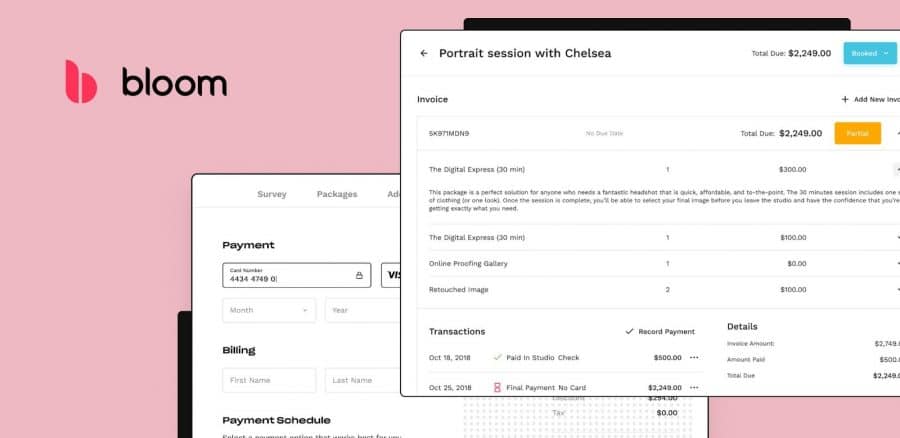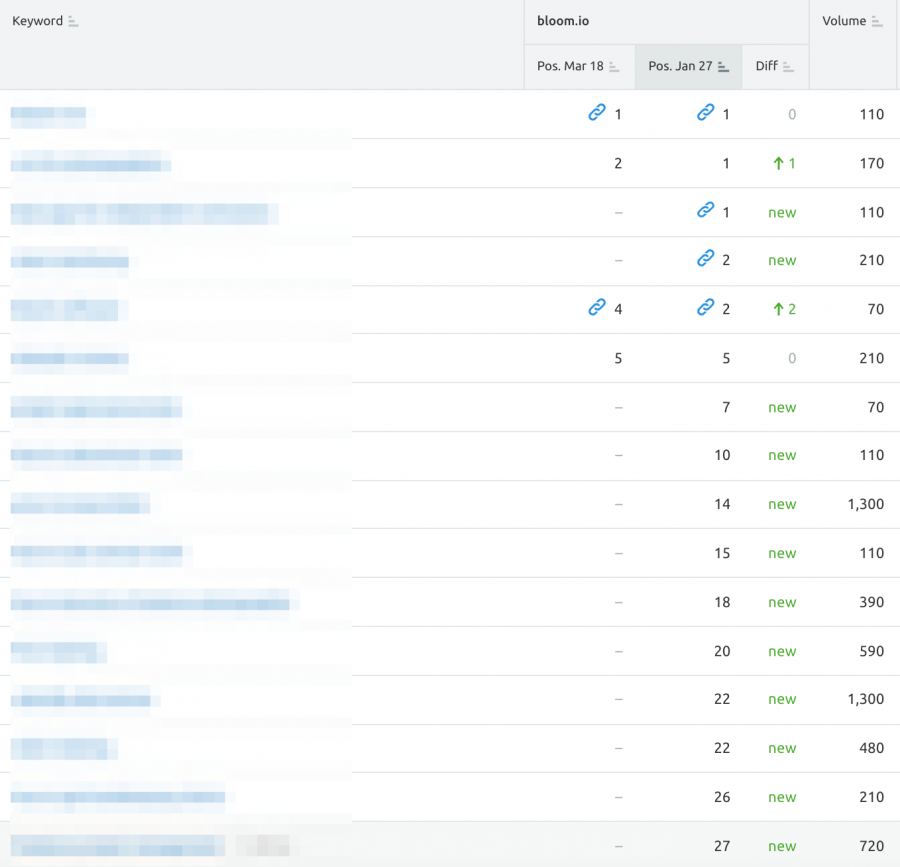Content marketing is a highly effective way to increase reach for software-as-a-service businesses. We’re a bit biased, but we’d say it’s the most effective tactic.
Not only does publishing content allow companies to drive inbound marketing traffic, but it gives them the opportunity to show they ‘know their stuff.’
Here’s an example of just how effective a strong content marketing strategy can be:
Bloom was transitioning from a previous brand, Picr, when they came to us to help them grow their business. They had seen positive gains through their own efforts but wanted to ramp it up.
Over the course of our ten-month relationship, we helped Bloom increase their organic traffic by 96% and trial sign-ups by 82.8%.
Dive in to find out how.
What Is Bloom?

It’s a customer relationship management (CRM) system that helps businesses organize all of their appointments and invoices in one place. As Picr, the company marketed specifically toward professional photographers, but they’ve since rebranded (which was part of the reason why they contacted us).
Bloom’s most valuable feature is its appointment-booking application. The user can embed a “Book an Appointment Now” form on their site, and when clients book appointments, they’re automatically added to their calendar. Photographers (and now entrepreneurs in all kinds of verticals) love this feature, as it helps them keep their schedules in order.
Why They Came to Us
One of Bloom’s founders worked with us before on previous projects. So when he started looking for ways to grow this CMS business, he knew our SEO skills could help.
Bloom’s marketing team had two primary goals:
-
Rebrand: They had just changed their brand name and wanted to expand their audience from just photographers to other types of solopreneurs and small businesses.
-
Lead generation: They wanted to get more website visitors signing up for their 14-day trial.
Although the company had dabbled in content marketing, their efforts weren’t paying off like they wanted, and they thought that we might be able to get their site performing at a higher level.
(And they were right!)
Getting to Work
We connected with Bloom at the perfect time. They knew they wanted to expand into new verticals, but they hadn’t yet defined those verticals. We got to help them figure that out.
The key was to find answers to these questions:
-
What does Bloom’s software do?
-
What problems does it solve for solopreneurs and small businesses?
-
What types of businesses struggle with those problems?
We knew that once we had a list of business types that matched Bloom’s pain point, we could build out some content that appealed to their interests and would attract them to the site through search engines.
Our Strategy and Action Steps
To find answers to the questions above, we conducted research into competitors and customer search behavior. We also had long calls with the Bloom team and got access to a Bloom account of our own to gain insight into how it works and why it’s valuable.
This research led to our initial strategy:
Market to freelancers who work on a gig-to-gig basis.
More specifically, we wanted to target freelancers in creative fields. If photographers find value in Bloom’s simple booking features, we found it likely that artists, event planners, and other creatives might find it helpful, too.
We also decided to continue targeting photographers, as there were a lot of SEO opportunities still there.
From that point, we dove into keyword research (learn more about our keyword research process here) and identified dozens of ranking opportunities related to our strategy.
The articles we published can be divided into three categories:
1. Niche-Specific
These articles, like How to Run a Successful Event Planning Business and Managing Commissions: A Guide for Freelance Artists target very specific audiences.
These articles were written for beginners just entering a new field (or even thinking about entering a new field). The goal was to introduce them to Bloom before they grew attached to another CRM system.
Our photography articles fall into this category, too.
In our keyword research process, we looked for opportunities to rank for photography-related keywords that Bloom’s marketing team had overlooked in their previous articles. This led to articles like How to Become a Freelance Photographer and 9 Tips for Scaling Your Freelance Photography Business?
2. General Freelancing
These articles targeted independent contractors in all stages of their careers — people thinking of quitting their jobs to go freelance, experienced solopreneurs, and everyone in between.
We wrote these blogs to answer the various questions freelancers might bump into:
-
How do you transition from part-time freelance to full-time freelance?
-
How do you book more clients?
-
What do you do if a client can’t pay you in full after the work is done?
-
How can you save on PayPal fees?
Each of the questions above (and many others) became the basis of its own article. In those articles, we answered the questions in detail, covering as many related questions as possible.
3. Software Reviews/Comparisons
These articles were targeted toward people researching CMS programs and similar types of software. If someone was researching Bloom’s competitors, we wanted to capture their attention.
Here are some example titles:
These articles were certainly the most ‘salesy’ of the bunch. While we were as honest as possible about each CMS’ strengths, we definitely wanted to highlight the features that made Bloom stand out.
In our 14-month contract with Bloom, we published just shy of 45 articles on their website.
Note: In all of these articles, we made a point to include at least one call-to-action to their 14-day trial sign-up page. While long-form, SEO’d guides are great for attracting leads to a website, it’s CTAs that drive conversions.
Related: read more about our SaaS SEO framework here.
Our Results
Between March 2020 to January 2021 — the duration of our contract with Bloom — their overall target keyword visibility increased by 147.3%.
Here’s a look at how some specific keyword rankings changed over the course of our relationship:

These keyword rankings, along with others, helped us drive significant traffic to Bloom’s page. By getting our articles in front of the people searching for these keywords, we were able to drive a lot of traffic to the website.
All in all, our content marketing efforts helped to increase Bloom’s organic traffic by 96%!
Conclusion
In content marketing, we talk about “evergreen content” a lot. We want to create content that will boost rankings now and that will continue to grow rankings in the future.
With Bloom, that plan is rolling right along. We wrapped up services with Bloom in early 2021, and at this time, the content Inter created for them is continuing to increase organic traffic to the site.
We’re proud to share these results:
-
67% of Bloom’s organic traffic is still generated from Intergrowth-created content.
-
More than half rank in the top five spots in Google for their target keywords.
-
Articles that we created for Bloom are contributing 76.5% organic visits to their top ranking articles.
-
Our work also drew 361 out of 739 referring domains linking to their site.
This kind of evergreen content will continue to interest Bloom’s target audience, who will continue to find it at the top of their search.
Think we might be able to help you grow your business? Click the link to get in touch!
Have burning questions about what it looks like to work with us? Read the short answers to the most common questions clients ask before working with us here.
SCALE YOUR ORGANIC TRAFFIC
Subscribe to our monthly newsletter



